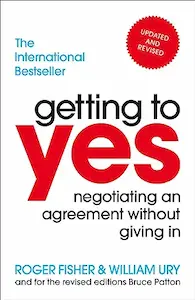Getting to Yes - Summary
Roger Fisher and William Ury

Introduction
“Getting to Yes” is a book written by Roger Fisher and William Ury that explores the art of negotiation. The book offers a step-by-step guide on how to negotiate effectively and reach a win-win agreement. The authors argue that negotiation is not a zero-sum game, where one party wins and the other loses, but rather a collaborative process that can benefit both parties. In this essay, I will provide a summary of the book and highlight some of the key points and examples presented by the authors.
The Four Principles of Negotiation
The authors present four principles of negotiation that are critical to reaching a successful agreement. The first principle is to separate the people from the problem. The authors argue that emotions and personal relationships can often get in the way of reaching an agreement. Therefore, it is essential to focus on the problem and not let personal feelings interfere with the negotiation process.
The second principle is to focus on interests, not positions. The authors argue that people often take positions based on their interests, and it is essential to understand the underlying interests to reach a mutually beneficial agreement. For example, in a salary negotiation, an employee may take a position of asking for a higher salary, but the underlying interest may be to feel valued and appreciated by the employer.
The third principle is to generate options for mutual gain. The authors argue that there are often multiple solutions to a problem, and it is essential to explore various options to find a mutually beneficial agreement. For example, in a divorce settlement, there may be several ways to divide assets that benefit both parties.
The fourth principle is to use objective criteria. The authors argue that using objective criteria, such as market value or industry standards, can help both parties reach a fair agreement. For example, in a business negotiation, using industry standards for pricing can help both parties reach a fair agreement.
The BATNA Concept
The authors introduce the concept of BATNA, which stands for Best Alternative To a Negotiated Agreement. The authors argue that it is essential to have a BATNA before entering into a negotiation. A BATNA is the alternative course of action that a party can take if the negotiation fails. The authors argue that having a strong BATNA can give a party more negotiating power and increase the likelihood of reaching a successful agreement.
The Importance of Communication
The authors stress the importance of communication in the negotiation process. They argue that effective communication can help parties understand each other’s interests and generate options for mutual gain. The authors provide several examples of how communication can be used effectively in negotiations. For example, active listening can help parties understand each other’s interests, and reframing can help parties find common ground.
Dealing with Difficult Negotiators
The authors provide strategies for dealing with difficult negotiators. They argue that difficult negotiators can often be dealt with by focusing on their interests and generating options for mutual gain. The authors provide several examples of how to deal with difficult negotiators. For example, if a negotiator is taking an extreme position, the other party can ask questions to understand their underlying interests and generate options that benefit both parties.
Conclusion
In conclusion, “Getting to Yes” is a valuable resource for anyone looking to improve their negotiation skills. The book provides a step-by-step guide on how to negotiate effectively and reach a win-win agreement. The authors stress the importance of separating the people from the problem, focusing on interests, generating options for mutual gain, and using objective criteria. The authors also introduce the concept of BATNA and stress the importance of communication in the negotiation process. Overall, “Getting to Yes” is a must-read for anyone looking to improve their negotiation skills and reach successful agreements.